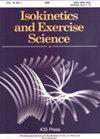同时进行高强度间歇训练和阻力训练对下半身最大力量和爆发力的影响:最新系统回顾和荟萃分析
IF 0.7
4区 医学
Q4 ENGINEERING, BIOMEDICAL
引用次数: 0
摘要
背景:耐力训练会对力量训练产生负面影响,并可能导致力量收益减少,这就是所谓的干扰效应。然而,高强度间歇训练(HIIT)作为一种耐力训练模式可能会减少这种干扰效应。目的:本系统综述和荟萃分析旨在研究同时进行 HIIT 和阻力训练(RT)对下半身爆发力和最大力量的影响。方法:检索了五个电子数据库。进行了分组分析,以评估同时进行 HIIT 和 RT 后,HIIT 方式、训练状态和训练持续时间对力量发展的影响。结果:元分析表明,与单独进行 RT 相比,同时进行 HIIT 和 RT 不会影响反向运动跳(CMJ)(WMD =-0.17,95%CI =-1.45 至-1.11)和半蹲(WMD =-0.05,95%CI =-2.42 至 2.32)的发展。此外,亚组分析显示,HIIT-跑步训练有利于CMJ和半蹲的发展。较长的训练时间对发展CMJ更有效,而较短的训练时间则更适合发展半蹲。此外,运动员比非运动员的进步更大。结论:结合 HIIT 和 RT 可以增强 CMJ 和半蹲能力。干预结果受训练变量和训练状态的影响。本文章由计算机程序翻译,如有差异,请以英文原文为准。
The effect of concurrent high-intensity interval training and resistance training on the lower body maximal strength and explosive power: A updated systematic review and meta-analysis
BACKGROUND: Endurance training can have a negative impact on strength training and may lead to reduced strength gains, known as the interference effect. However, high-intensity interval training (HIIT) as an endurance training mode may reduce this interference effect. OBJECTIVE: This systematic review and meta-analysis aim to investigate the effects of concurrent HIIT and resistance training (RT) on lower body explosive strength and maximum strength. METHODS: Five electronic databases were searched. Subgroup analyses were performed to assess the effects of HIIT modality, training status, and training duration on strength development following concurrent HIIT and RT. RESULTS: Meta-analysis showed that compared to RT alone, concurrent HIIT and RT will not affect the development of countermovement jump (CMJ) (WMD =-0.17, 95%CI =-1.45 to -1.11) and half squat (WMD =-0.05, 95%CI =-2.42 to 2.32). Further, subgroup analysis revealed that HIIT-running workout was conducive to the development of both CMJ and half squat. Longer training duration was found to be more effective in developing CMJ, while shorter training duration was more suitable for developing half squat. Additionally, athletes showed greater improvement than non-athletes. CONCLUSIONS: Combining HIIT and RT can enhance CMJ and half squat. The results of intervention are moderated by training variables and training status.
求助全文
通过发布文献求助,成功后即可免费获取论文全文。
去求助
来源期刊

Isokinetics and Exercise Science
医学-工程:生物医学
CiteScore
1.20
自引率
14.30%
发文量
37
审稿时长
>12 weeks
期刊介绍:
Isokinetics and Exercise Science (IES) is an international journal devoted to the study of theoretical and applied aspects of human muscle performance. Since isokinetic dynamometry constitutes the major tool in this area, the journal takes a particular interest in exploring the considerable potential of this technology.
IES publishes studies associated with the methodology of muscle performance especially with respect to the issues of reproducibility and validity of testing, description of normal and pathological mechanical parameters which are derivable from muscle testing, applications in basic research topics such as motor learning paradigms and electromyography. The journal also publishes studies on applications in clinical settings and technical aspects of the various measurement systems employed in human muscle performance research.
The journal welcomes submissions in the form of research papers, reviews, case studies and technical reports from professionals in the fields of sports medicine, orthopaedic and neurological rehabilitation and exercise physiology.
 求助内容:
求助内容: 应助结果提醒方式:
应助结果提醒方式:


